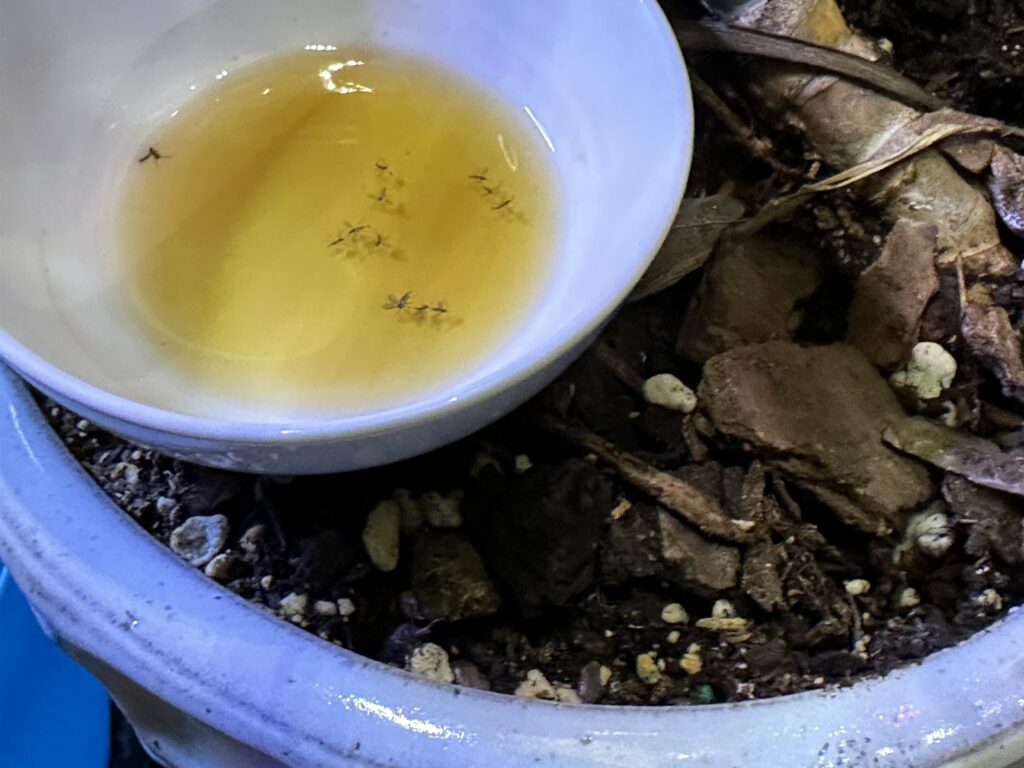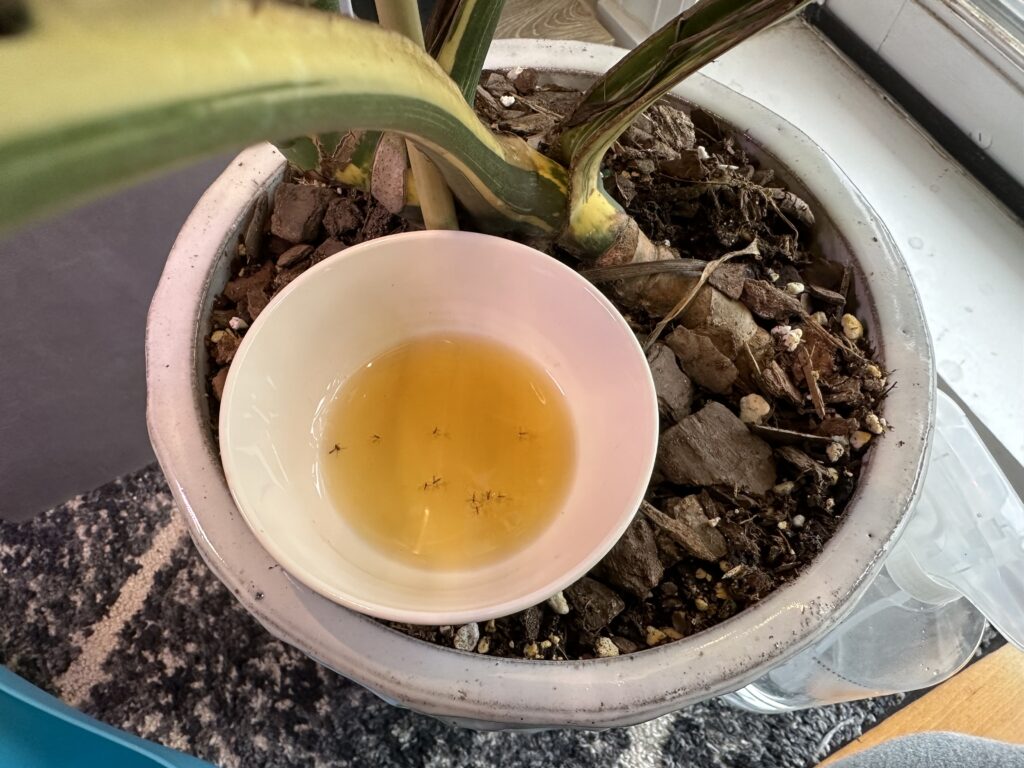You’ll likely notice them slowly. A small fly here or there. But you soon discover that a houseplant or several in your room are home to gnats – annoying little flies attracted to light and that make themselves at home in the soil of your houseplants. While these pests are more of an annoyance than anything, learning how to get rid of gnats in plants, and the steps to take to prevent them in the first place will make sure they don’t find refuge in your plants.
Where do gnats come from?
While there are a few different ways for gnats to enter your home, the most likely way they arrive is from soil or recently purchased plants that have an existing population of gnats.
We’ve all been there. A plant looks great at the nursery and doesn’t have any red flags during your in-store inspection. You take it home to find small flying bugs slowly appearing in your rooms. While inspecting plants in-store is one of the best ways to find pests, it’s not 100% fool-proof. While you may not notice any active adult gnats flying around nursery plants, finding eggs planted in the soil is next to impossible.
Because of this, we recommend keeping newly purchased plants isolated on their own for a few days after bringing them home in the event there are gnats or other pests present.
The same thing rings true for soil. Different companies have a variety of sources for the organic components of new dirt. The rich, damp environment of new soil bags ripe with nutritious organic material inside is the perfect breeding ground for gnats. And if a handful of adults survive bagging, they can lay hundreds of eggs between leaving the manufacturer and arriving at your home. And since bags aren’t vacuum sealed, they can survive for many months, infecting your plants when its time to repot.
If while shopping, you notice any flying pests in or around the plants or soil you’re looking to purchase, it may be smart to find another store or wait a few weeks to avoid bringing a new gnat infestation home. It could otherwise risk your existing plants, and knowing how to get rid of gnats in plants is not an easy undertaking.
Do gnats harm plants?
If you find yourself with gnats at home, there is something positive: gnats are harmless to your plants. Unlike other pests and infections, gnats will not impact your plant’s leaves or roots. Their main goal is to breed in the damp substrate of your plant’s soil.
While you may notice gnats on your plant’s stems or leaves, they will cause more annoyance than damage to your plant.
Can gnats spread to other plants?
Gnats have one superpower, and it’s quickly finding and spreading to uninfected plants. While you likely may notice gnat activity concentrated around your plant, over time these annoying pests will discover other rooms and lay their eggs in new plants.
Early discovery and elimination are key to preventing a population explosion.
How to eliminate gnats

Gnats can be eliminated, but it will unfortunately take time. While killing adult gnats with sticky paper or lures may feel like progress, it’s one piece of the gnat lifecycle.
Gnats can lay dozens, if not hundreds of eggs. Eliminating the adults and these eggs will be the only way to wipe out a gnat colony for good.
Catching adult gnats
The best way to capture gnats is by placing a small cup or dish with a few ounces of apple cider vinegar directly next to your infected plant pot. The sweet smell will naturally attract the gnats inside, where they will get stuck in the liquid and die.
This may take 1-2 days, but you should start to see gnats begin to accumulate on the surface. Refill the dish as needed. While purchasable sticky pads replicate this, I’d recommend starting with apple cider first as a much more cost-effective way to kill gnats. This is the first step in learning how to get rid of gnats in plants or soil.
Killing gnat eggs and larvae
With apple cider vinegar traps set for adults, we can shift to dealing with the eggs these adults have likely laid in your plant’s soil.
The first thing to do is check the moisture level. If your plant soil regularly feels wet or damp, this creates a prime breeding ground for gnats. If possible, replace the top 1 – 2 inches of soil with new, well-draining soil that you know to be un-infested. Due to their size, gnats dig shallow holes to lay their eggs. Replacing the top layer should disrupt any incubating gnats.
Be sure to immediately remove the infected soil and dispose of it outside to prevent any hatching gnats from escaping.
Spraying plant-safe insecticide
While apple cider vinegar can help capture adult gnats, it may not be as effective killing the eggs or larvae in the soil. Finding an insecticide that is also safe for houseplants will take care of the eggs and larvae before they develop into adults. Verify that any sprays are safe for use within houseplants, and follow the directions on the bottle to ensure you use it properly. Within 1-2 treatments, you should be able to end your gnat problem.
How to prevent gnats in the first place
While hindsight is always 20/20, there are a few proactive measures to take to avoid gnat infestations in the first place. Putting this plan in place will not completely guarantee you’ll be free from pests in the future, but it will dramatically decrease the odds of future gnats finding their ways into your home.
- Keep any new plants quarantined from others in your home for a minimum of two weeks in a separate room. If you notice pets once you get home, return the plant immediately.
- Similar for soil, look to see if there are any signs of gnats when opening the bag for the first time. Depending on the season, storing soil outdoors during cold winter months will help kill any pests that may have hitched a ride from the nursery.
- Keep your plant soil dry. While you should follow your specific plant care instructions, a majority of tropical houseplants welcome dryness between waterings. Gnats naturally seek out damp environments to breed, and keeping your soil dry will help prevent dramatic increases in population.
- Use well-draining soil in containers designed with drainage holes to avoid excess water from pooling.
- Promote good air circulation. Like other pests, gnats thrive in areas with poor air circulation. Fans are a great way to make your plants feel hostile to their weak wings with a small and ongoing breeze.
- Don’t stop treatment prematurely. It may be tempting to celebrate a day or two of no gnat sightings after following this guide. Keep your apple cider vinegar saucer near your plants for several days following to catch any additional gnats that could otherwise start a new colony.
How to get rid of gnats in plants – last thoughts
Realize gnats are likely the most common issue plant owners face. All growers encounter gnats at some point in their plant journey.
It has nothing to do with your home’s cleanliness or the health of your plants. Focus on quick treatment to eliminate the issue, and learn to pinpoint the plant or soil that may have brought the pests into your home.

